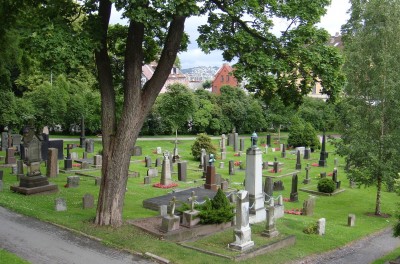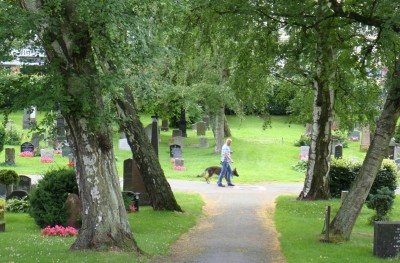Despite recent controversy over tourists found camping in some of Norway’s scenic graveyards, residents themselves are increasingly using local well-tended cemeteries as an alternative to parks. The resting places of the dead can actually be full of life, and the ultimate “green lung” for those in search of a breather.

On a recent summer afternoon at Norway’s most historic and well-known cemetery, Vår Frelsers (Our Saviours) in Oslo, residents could be seen walking their dogs, cycling and strolling with baby carriages. The cemetery is the final resting place for some of Norway’s most important political and cultural heroes, including literary giant Henrik Ibsen. The well-tended graveyard with its many monuments and leafy trees attracts more than those who come to plant flowers on relatives’ graves.
The sight of locals using Vår Frelsers cemetery as a venue for recreation is not unique, as city dwellers seek out a quiet place to go on a sunny afternoon, or even when it’s raining or snowing. Newspaper Dagsavisen first wrote about “life around the graves” last winter, citing a new study at the time that charted the use of two other cemeteries in Oslo, Gamlebyen and Østre Gravlund, over a four-month period.

“We were surprised over the wide range of activities,” Helena Nordh, an assistant professor at Norway’s university in Ås, NMBU, told Dagsavisen. Nordh and fellow researchers from the Norwegian cultural and historic research institute NIKU and the Norwegian institute for nature research NINA found that several thousand people streamed through the cemeteries in the course of the four months, to sit quietly on benches and sometimes read, take walks with friends or family, and even have a picnic or eat on benches under the trees. Some children played while others wandered around and studied the gravestones.
“There were also many others who consciously chose to walk or cycle through the graveyards because they thought it was peaceful and pretty,” Nordh said. She told Dagsavisen that most of the people the researchers encountered and spoke with were not there to visit relatives’ graves but rather because they were on a walk.
Among them was Dunja Sukalic who said she often walks her dog on a leash in the Gamlebyen graveyard, located near Oslo’s oldest settlements from more than 1,000 years ago. “It’s much nicer to be here than in a park,” Sukalic told Dagsavisen. “It’s so tidy and green here, and there are more benches here than in a park.”
Importance of maintaining respect
Complaints have been voiced this summer over campers who have pitched tents in the graveyard around churches in Lofoten, and used their watering facilities to wash themselves. That’s been condemned as disrespectful, and not everyone appreciates cycling, jogging or children using the graveyards as a playground either.
“Those we have spoken with say there’s a limit to what types of activity are acceptable,” Nordh said. “It has to do with respect for the dead and their families.”
Last month, one Oslo resident, Eva Ramm, wrote a column in newspaper Aftenposten about how much she appreciates the Vår Frelsers cemetery, located in the heart of the city.”What a pearl of a cemetery it still is, dating back to 1808,” Ramm wrote, claiming that she’s taken daily walks through it for 30 years.
Meanwhile, much farther south in the coastal city of Arendal, one of its cemeteries was used once again just last week as the site of a concert that was part of the annual Canal Street music festival. Veteran singer-songwriter Ole Paus was the latest to perform in what concert organizers billed as “a magical evening” pairing the stillness and order of the churchyard with Paus’ music.
The festival is proud of mounting concerts in what it claims is “Norway’s most beautiful cemetery … a borderline area between life and death, a place where we can reminisce about life’s beginning and end, fellowship and roots.” Other artists performing in the Arendal cemetery have included the renowned Sami singer Mari Boine and jazz musician Tord Gustavsen.
newsinenglish.no/Nina Berglund

